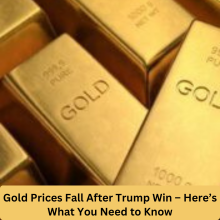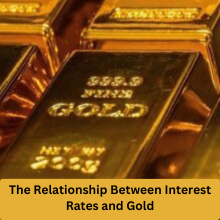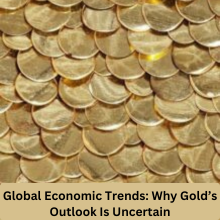
Gold prices have taken a hit recently, dropping to a near three-week low. This decline comes as the U.S. dollar surges following Republican candidate Donald Trump’s remarkable comeback victory. Investors are also shifting their focus to the upcoming Federal Reserve policy meeting, where they’re expecting signs on how quickly interest rate cuts will come. Gold, a traditional hedge against inflation, has seen significant price fluctuations in recent months due to these two major factors—the political shift and potential changes in monetary policy.
In this article, we will explore why gold prices are retreating, what impact Trump’s election win has on the market, and how the Federal Reserve’s actions could influence gold’s future price trajectory. We’ll also look at how gold interacts with the dollar, tariffs, and inflation, and what investors should be considering going forward.
Gold Retreats to a Three-Week Low
As of November 6, spot gold was trading at $2,703.93 per ounce, a 1.5% drop from previous levels. The decline marks the lowest point for gold in nearly three weeks, following a record high of $2,790.15 just last Thursday. This sudden dip in gold’s price has caught the attention of investors who had been expecting the yellow metal to continue its bullish momentum due to rising inflation concerns and political uncertainty.
What’s driving this retreat? A combination of factors, including the US’s strong economic policy, indicates that its relationship with the US will only get stronger. dollar, political developments, and investor sentiment. When the dollar strengthens, it typically makes gold more expensive for buyers holding other currencies, thus reducing demand. Gold’s status as a safe-haven asset means it often rises during times of geopolitical instability or economic turmoil. But when the dollar rises, it can undercut this advantage.
The Trump Factor: A Game Changer for Gold
The recent political shockwaves caused by Donald Trump’s election victory have been felt across global markets. His victory, though unexpected, has introduced a wave of uncertainty, and that’s where gold tends to thrive. Gold traditionally performs well in times of political turmoil because investors turn to it as a safe-haven asset.
However, Trump’s policies could have a unique impact on gold’s price. Many traders are anticipating that Trump will push for higher tariffs, particularly on trade with China. This has the potential to increase inflationary pressures, which, in turn, could drive demand for gold as an inflation hedge.
The Dollar’s Surge: What Does It Mean for Gold?
One of the key reasons behind the recent drop in gold prices is the sharp rise in the U.S. dollar. The dollar reached a four-month high, making gold more expensive for buyers who use other currencies. This phenomenon is often referred to as the “inverse relationship” between the dollar and gold. As the dollar strengthens, gold becomes less affordable in other parts of the world, which reduces demand.
A strong dollar also impacts the global commodity markets, pushing down the price of other metals like silver, platinum, and palladium. Investors are watching the dollar’s movements closely because its strength could mean more volatility for gold in the coming weeks.
Fed Policy and Its Role in Gold’s Movement
The Federal Reserve’s monetary policy plays a huge role in determining gold’s price. When the Fed raises interest rates, it increases the opportunity cost of holding non-yielding assets like gold. Conversely, when the Fed cuts rates, gold becomes more attractive because it doesn’t pay interest but can benefit from the lower opportunity costs.
Investors are especially keen to see what the Fed will do next. The central bank is expected to announce a quarter-point rate cut soon, following a 50-basis-point cut in September. While a rate cut could provide some support to gold prices, the bigger question is whether the Fed will signal that it’s ready to pause further cuts. This could have a mixed effect on gold, depending on whether inflation concerns or interest rate policies take center stage.
The Relationship Between Interest Rates and Gold
Interest rates and gold prices share a closely linked relationship. Generally speaking, when interest rates rise, gold becomes less attractive because investors can earn higher returns from interest-bearing assets like bonds and savings accounts. This leads to a reduction in demand for gold.
On the other hand, when interest rates fall, gold becomes more appealing because it doesn’t yield interest, but its value rises as other investments become less attractive. The Fed’s policy decisions will be crucial in determining how much further gold prices can rise or fall in the coming months.
Gold as a Hedge Against Inflation
Gold has long been considered a hedge against inflation. As prices rise for goods and services, the purchasing power of fiat currencies tends to decline. Investors flock to gold during these times because it tends to hold its value better than paper currencies. With inflation on the rise due to potential tariff increases under Trump’s administration, gold is once again being seen as a safe store of value.
However, gold’s status as an inflation hedge is not foolproof. If the Fed raises interest rates sharply to combat inflation, it could hurt gold prices. So, investors will need to balance the inflationary pressures with the potential for higher rates when making investment decisions.
Bullion’s Stunning Rally in 2024: What’s Driving It?
Gold has experienced an incredible rally in 2024, climbing nearly 50% from its value at the start of the year. This impressive surge is attributed to a combination of factors, including ongoing geopolitical uncertainty, rising inflation fears, and expectations that the Fed will continue to cut rates.
The rally was especially pronounced after the U.S. presidential election results were announced. Trump’s unexpected win caused a spike in gold prices as investors sought refuge in the metal amidst uncertainty.
The Trump Administration vs. Biden Administration: Gold’s Response
Gold has historically reacted to political shifts in the United States, and this trend is likely to continue under the Trump administration. During his first term, gold saw a dramatic 54% increase, a reflection of market instability and his unpredictable policy moves. Under the Biden administration, gold has also performed well, rising by around 50%. The key question now is how gold will react to Trump’s second term.
The market’s response will depend on a variety of factors, including Trump’s trade policies, fiscal stimulus, and his stance on interest rates.
Also read: Denver School Closures: Snow Forces Delays Across Metro
The Fed’s Upcoming Policy Announcement: What to Expect
As the Federal Reserve’s two-day policy meeting comes to a close, markets are eagerly awaiting its announcement. The expectation is that the Fed will continue its rate-cutting cycle, but many investors are focused on what the Fed signals about future cuts. Any hints that rate cuts may slow down could have a significant impact on gold prices.
Gold’s Safe Haven Status: Is It Losing Its Shine?
Gold has long been seen as a safe-haven asset, particularly during times of economic or political uncertainty. But as markets become more volatile and inflation fears rise, investors may be questioning whether gold is still the best place to park their money. While gold has held up well in the face of recent economic challenges, it remains to be seen whether it can continue its upward trajectory.
Impact of the Strong Dollar on Other Commodities
The strength of the dollar is not only impacting gold prices but also other key commodities, including silver, platinum, and palladium. These metals have all seen price drops, and their prices are also closely tied to the strength of the dollar. As the dollar strengthens, demand for these commodities falls, further driving down prices.
Global Economic Trends: Why Gold’s Outlook Is Uncertain
While gold is often seen as a safe bet during uncertain times, the global economic landscape is rapidly changing. Rising geopolitical tensions, shifting trade relations, and the ongoing impacts of inflation are all contributing to gold’s unpredictable price movement.
What Investors Should Know About Gold’s Future
Looking ahead, investors should be cautious when it comes to gold. While the metal may continue to serve as a hedge against inflation, its future performance will depend largely on economic conditions and Fed policy decisions.
Also read: Trump’s Historic Win: What World Leaders Are Saying
Conclusion
As gold prices fluctuate in response to political shifts, Fed decisions, and economic factors, investors will need to remain vigilant. While gold continues to be a popular hedge against inflation and economic uncertainty, its appeal may be tested by stronger dollars and higher interest rates.
FAQs
-
What are the main factors driving the price of gold in 2024?
- Political uncertainty, inflation concerns, and the Federal Reserve’s policy decisions are the primary factors affecting gold prices.
-
Why does the dollar impact the price of gold?
- A stronger dollar makes gold more expensive for foreign buyers, reducing its demand and driving prices down.
-
Is gold still a good investment in today’s economy?
- While gold is a solid hedge against inflation, its performance will depend on factors like interest rates and geopolitical tensions.
-
How can geopolitical events influence gold prices?
- Political instability often leads to increased demand for gold as a safe-haven asset, driving its price up.
-
Will the Federal Reserve’s rate cuts make gold prices rise or fall?
- Rate cuts generally support gold prices, but if the Fed signals that cuts will slow down, gold could face downward pressure.

